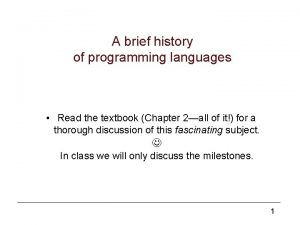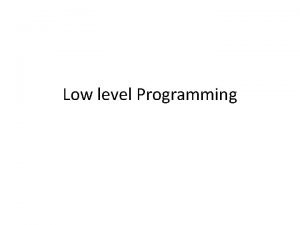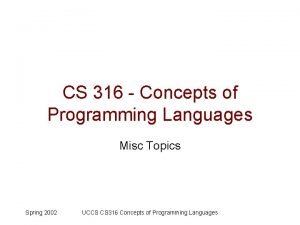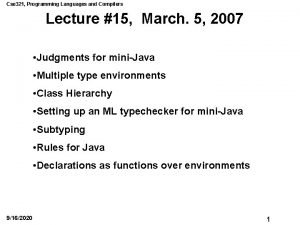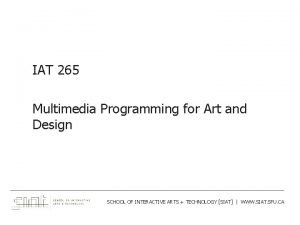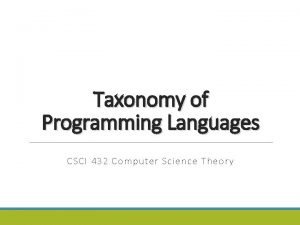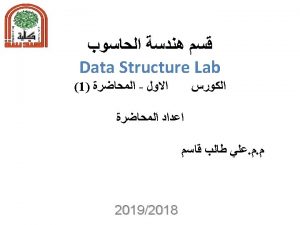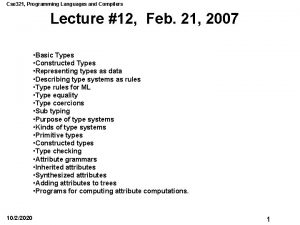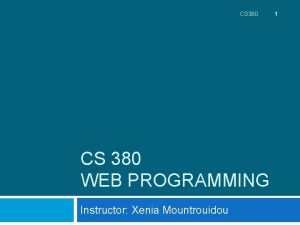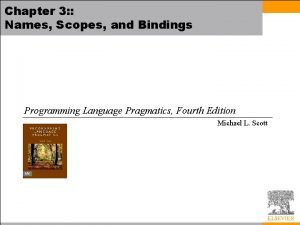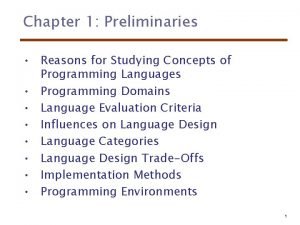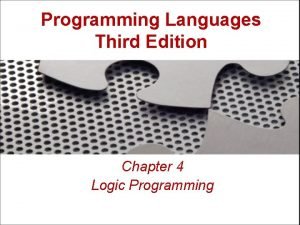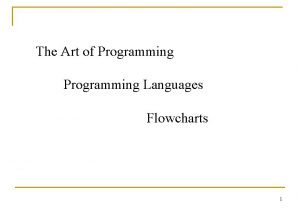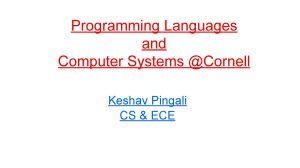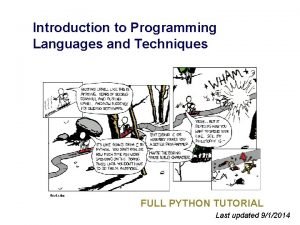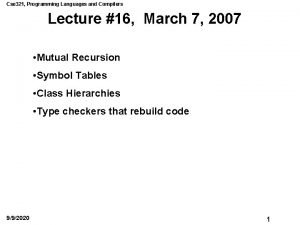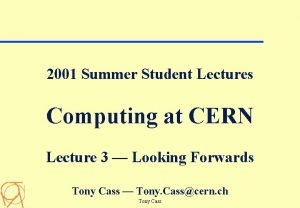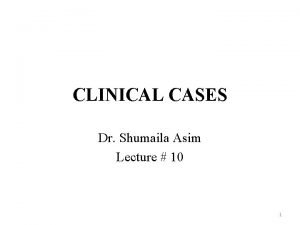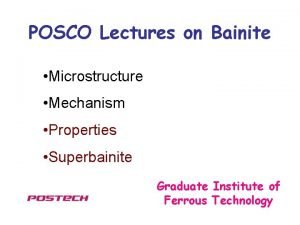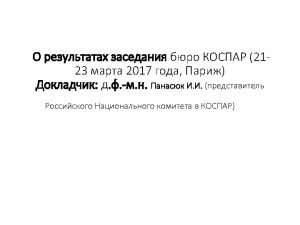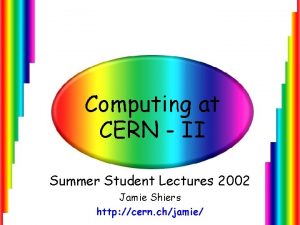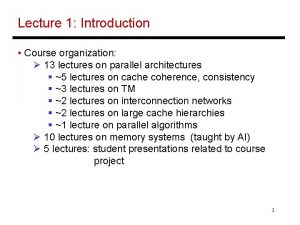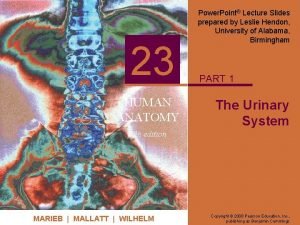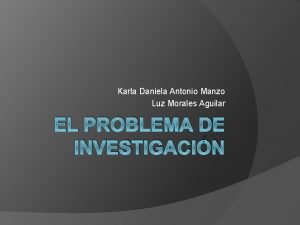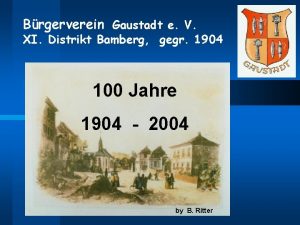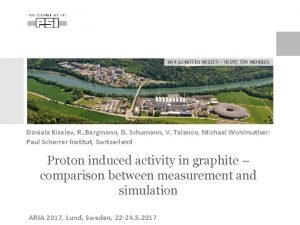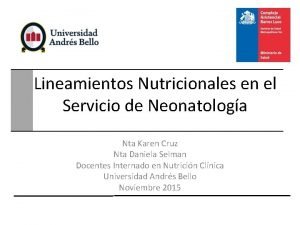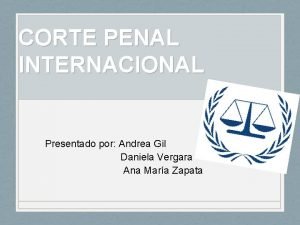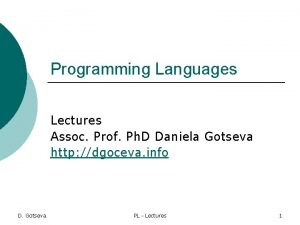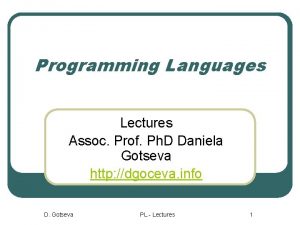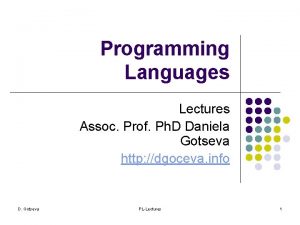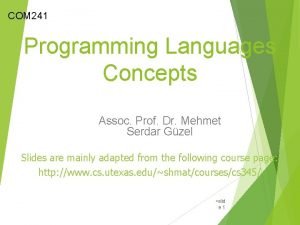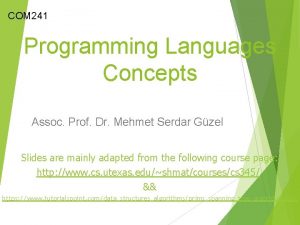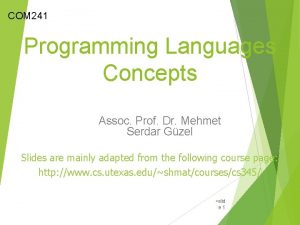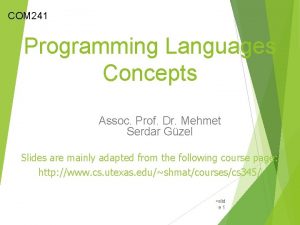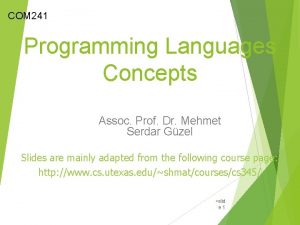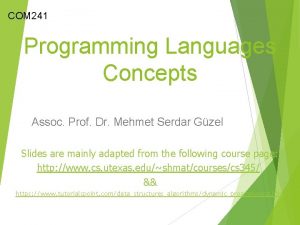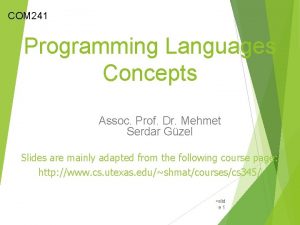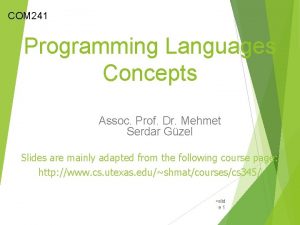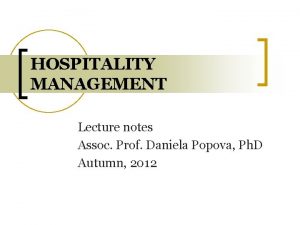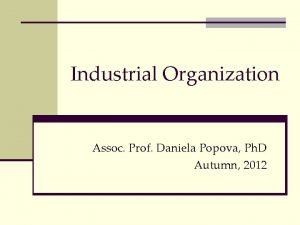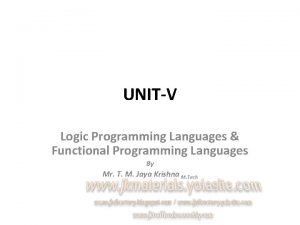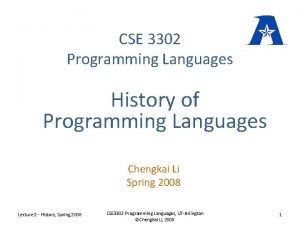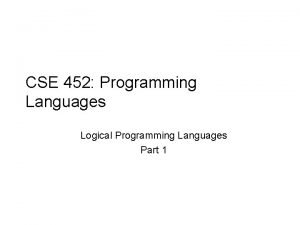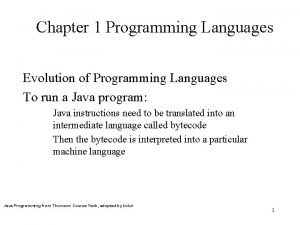Programming Languages Lectures Assoc Prof Ph D Daniela

















![Pointers and Function Arguments n Each call sets array[n] to the next integer found Pointers and Function Arguments n Each call sets array[n] to the next integer found](https://slidetodoc.com/presentation_image_h/1ad9c99f48ed0c5c3e7131c4b0b0ada2/image-18.jpg)


![Pointers and Arrays The declaration int a[10]; n defines an array of size 10, Pointers and Arrays The declaration int a[10]; n defines an array of size 10,](https://slidetodoc.com/presentation_image_h/1ad9c99f48ed0c5c3e7131c4b0b0ada2/image-21.jpg)




![Pointers and Arrays As formal parameters in a function definition, char s[]; n and Pointers and Arrays As formal parameters in a function definition, char s[]; n and](https://slidetodoc.com/presentation_image_h/1ad9c99f48ed0c5c3e7131c4b0b0ada2/image-26.jpg)


















![Character Pointers and Functions There is an important difference between these definitions: char amessage[] Character Pointers and Functions There is an important difference between these definitions: char amessage[]](https://slidetodoc.com/presentation_image_h/1ad9c99f48ed0c5c3e7131c4b0b0ada2/image-45.jpg)
































![Command-line Arguments n n By convention, argv[0] is the name by which the program Command-line Arguments n n By convention, argv[0] is the name by which the program](https://slidetodoc.com/presentation_image_h/1ad9c99f48ed0c5c3e7131c4b0b0ada2/image-78.jpg)




























- Slides: 106

Programming Languages Lectures Assoc. Prof. Ph. D Daniela Gotseva http: //dgoceva. info D. Gotseva PL-Lectures 1

Pointers and Arrays Part I Lecture No 8 D. Gotseva PL-Lectures 2

Pointers and Arrays n n A pointer is a variable that contains the address of a variable. Pointers are much used in C, partly because they are sometimes the only way to express a computation, and partly because they usually lead to more compact and efficient code than can be obtained in other ways. Pointers and arrays are closely related; this chapter also explores this relationship and shows how to exploit it. D. Gotseva PL-Lectures 3

Pointers and Arrays Pointers have been lumped with the goto statement as a marvelous way to create impossible to understand programs. This is certainly true when they are used carelessly, and it is easy to create pointers that point somewhere unexpected. n With discipline, however, pointers can also be used to achieve clarity and simplicity. n D. Gotseva PL-Lectures 4

Pointers and Arrays The main change in ANSI C is to make explicit the rules about how pointers can be manipulated, in effect mandating what good programmers already practice and good compilers already enforce. n In addition, the type void * (pointer to void) replaces char * as the proper type for a generic pointer. n D. Gotseva PL-Lectures 5

Pointers and Addresses n n A typical machine has an array of consecutively numbered or addressed memory cells that may be manipulated individually or in contiguous groups. One common situation is that any byte can be a char, a pair of one-byte cells can be treated as a short integer, and four adjacent bytes form a long. A pointer is a group of cells (often two or four) that can hold an address. So if c is a char and p is a pointer that points to it, we could represent the situation this way: D. Gotseva PL-Lectures 6

Pointers and Addresses n The unary operator & gives the address of an object, so the statement р = &с; assigns the address of c to the variable p, and p is said to ``point to'' c. The & operator only applies to objects in memory: variables and array elements. n It cannot be applied to expressions, constants, or register variables. n D. Gotseva PL-Lectures 7

Pointers and Addresses The unary operator * is the indirection or dereferencing operator; when applied to a pointer, it accesses the object the pointer points to. n Suppose that x and y are integers and ip is a pointer to int. This artificial sequence shows how to declare a pointer and how to use & and *: int x = 1, y = 2, z[10]; int *ip; /* ip is a pointer to int */ ip = &x; /* ip now points to x */ y = *ip; /* y is now 1 */ *ip = 0; /* x is now 0 */ ip = &z[0]; /* ip now points to z[0] */ n D. Gotseva PL-Lectures 8

Pointers and Addresses The declaration of the pointer ip, int *ip; n is intended as a mnemonic; it says that the expression *ip is an int. The syntax of the declaration for a variable mimics the syntax of expressions in which the variable might appear. This reasoning applies to function declarations as well. n For example, double *dp, atof(char *); n says that in an expression *dp and atof(s) have values of double, and that the argument of atof is a pointer to char. n D. Gotseva PL-Lectures 9

Pointers and Addresses You should also note the implication that a pointer is constrained to point to a particular kind of object: every pointer points to a specific data type. n There is one exception: n ¨a “pointer to void'' is used to hold any type of pointer but cannot be dereferenced itself. D. Gotseva PL-Lectures 10

Pointers and Addresses If ip points to the integer x, then *ip can occur in any context where x could, so *ip = *ip + 10; n increments *ip by 10. n D. Gotseva PL-Lectures 11

Pointers and Addresses The unary operators * and & bind more tightly than arithmetic operators, so the assignment y = *ip + 1 n takes whatever ip points at, adds 1, and assigns the result to y, while *ip += 1 n increments what ip points to. n D. Gotseva PL-Lectures 12

Pointers and Addresses What do operators: ++*ip n and (*ip)++ n The parentheses are necessary in this last example; without them, the expression would increment ip instead of what it points to, because unary operators like * and ++ associate right to left. n Finally, since pointers are variables, they can be used without dereferencing. For example, if iq is another pointer to int, iq = ip n copies the contents of ip into iq, thus making iq point to whatever ip pointed to. n D. Gotseva PL-Lectures 13

Pointers and Function Arguments n n Since C passes arguments to functions by value, there is no direct way for the called function to alter a variable in the calling function. For instance, a sorting routine might exchange two out-of-order arguments with a function called swap. It is not enough to write swap(а, b); D. Gotseva PL-Lectures 14

Pointers and Function Arguments Because of call by value, swap can't affect the arguments a and b in the routine that called it. n The function above swaps copies of a and b. n The way to obtain the desired effect is for the calling program to pass pointers to the values to be changed: swap(&a, &b); n Since the operator & produces the address of a variable, &a is a pointer to a. In swap itself, the parameters are declared as pointers, and the operands are accessed indirectly through them. n D. Gotseva PL-Lectures 15

Pointers and Function Arguments D. Gotseva PL-Lectures 16

Pointers and Function Arguments n n n Pointer arguments enable a function to access and change objects in the function that called it. As an example, consider a function getint that performs free-format input conversion by breaking a stream of characters into integer values, one integer per call. getint has to return the value it found also signal end of file when there is no more input. These values have to be passed back by separate paths, for no matter what value is used for EOF, that could also be the value of an input integer. One solution is to have getint return the end of file status as its function value, while using a pointer argument to store the converted integer back in the calling function. D. Gotseva PL-Lectures 17
![Pointers and Function Arguments n Each call sets arrayn to the next integer found Pointers and Function Arguments n Each call sets array[n] to the next integer found](https://slidetodoc.com/presentation_image_h/1ad9c99f48ed0c5c3e7131c4b0b0ada2/image-18.jpg)
Pointers and Function Arguments n Each call sets array[n] to the next integer found in the input and increments n. Notice that it is essential to pass the address of array[n] to getint. Otherwise there is no way for getint to communicate the converted integer back to the caller. D. Gotseva PL-Lectures 18

Pointers and Function Arguments n Our version of getint returns EOF for end of file, zero if the next input is not a number, and a positive value if the input contains a valid number. D. Gotseva PL-Lectures 19

Pointers and Arrays In C, there is a strong relationship between pointers and arrays, strong enough that pointers and arrays should be discussed simultaneously. Any operation that can be achieved by array subscripting can also be done with pointers. n The pointer version will in general be faster but, at least to the uninitiated, somewhat harder to understand. n D. Gotseva PL-Lectures 20
![Pointers and Arrays The declaration int a10 n defines an array of size 10 Pointers and Arrays The declaration int a[10]; n defines an array of size 10,](https://slidetodoc.com/presentation_image_h/1ad9c99f48ed0c5c3e7131c4b0b0ada2/image-21.jpg)
Pointers and Arrays The declaration int a[10]; n defines an array of size 10, that is, a block of 10 consecutive objects named a[0], a[1], . . . , a[9]. n The notation a[i] refers to the i-th element of the array. If pa is a pointer to an integer, declared as int *pa; n the assignment pa = &a[0]; n sets pa to point to element zero of a; that is, pa contains the address of a[0]. n D. Gotseva PL-Lectures 21

Pointers and Arrays Now the assignment x = *pa; n will copy the contents of a[0] into x. n If pa points to a particular element of an array, then by definition pa+1 points to the next element, pa+i points i elements after pa, and pa-i points i elements before. Thus, if pa points to a[0], *(pa+1) n refers to the contents of a[1], pa+i is the address of a[i], and *(pa+i) is the contents of a[i]. n D. Gotseva PL-Lectures 22

Pointers and Arrays The correspondence between indexing and pointer arithmetic is very close. By definition, the value of a variable or expression of type array is the address of element zero of the array. Thus after the assignment pa = &a[0]; n pa and a have identical values. Since the name of an array is a synonym for the location of the initial element, the assignment pa=&a[0] can also be written as pa = a; n D. Gotseva PL-Lectures 23

Pointers and Arrays n n n Rather more surprising, at first sight, is the fact that a reference to a[i] can also be written as *(a+i). In evaluating a[i], C converts it to *(a+i) immediately; the two forms are equivalent. Applying the operator & to both parts of this equivalence, it follows that &a[i] and a+i are also identical: a+i is the address of the i-th element beyond a. As the other side of this coin, if pa is a pointer, expressions might use it with a subscript; pa[i] is identical to *(pa+i). In short, an arrayand-index expression is equivalent to one written as a pointer and offset. There is one difference between an array name and a pointer that must be kept in mind. A pointer is a variable, so pa=a and pa++ are legal. But an array name is not a variable; constructions like a=pa and a++ are illegal. D. Gotseva PL-Lectures 24

Pointers and Arrays n When an array name is passed to a function, what is passed is the location of the initial element. Within the called function, this argument is a local variable, and so an array name parameter is a pointer, that is, a variable containing an address. We can use this fact to write another version of strlen, which computes the length of a string. D. Gotseva PL-Lectures 25
![Pointers and Arrays As formal parameters in a function definition char s n and Pointers and Arrays As formal parameters in a function definition, char s[]; n and](https://slidetodoc.com/presentation_image_h/1ad9c99f48ed0c5c3e7131c4b0b0ada2/image-26.jpg)
Pointers and Arrays As formal parameters in a function definition, char s[]; n and char *s; n are equivalent; we prefer the latter because it says more explicitly that the variable is a pointer. When an array name is passed to a function, the function can at its convenience believe that it has been handed either an array or a pointer, and manipulate it accordingly. It can even use both notations if it seems appropriate and clear. n D. Gotseva PL-Lectures 26

Pointers and Arrays It is possible to pass part of an array to a function, by passing a pointer to the beginning of the subarray. For example, if a is an array, f(&a[2]) n and f(a+2) n both pass to the function f the address of the subarray that starts at a[2]. Within f, the parameter declaration can read f(int arr[]) {. . . } n or f(int *arr) {. . . } n So as far as f is concerned, the fact that the parameter refers to part of a larger array is of no consequence. n D. Gotseva PL-Lectures 27

Pointers and Arrays n If one is sure that the elements exist, it is also possible to index backwards in an array; p[-1], p[-2], and so on are syntactically legal, and refer to the elements that immediately precede p[0]. Of course, it is illegal to refer to objects that are not within the array bounds. D. Gotseva PL-Lectures 28

Demonstration EX 71. C D. Gotseva PL-Lectures 29

Address Arithmetic n n If p is a pointer to some element of an array, then p++ increments p to point to the next element, and p+=i increments it to point i elements beyond where it currently does. These and similar constructions are the simples forms of pointer or address arithmetic. C is consistent and regular in its approach to address arithmetic; its integration of pointers, arrays, and address arithmetic is one of the strengths of the language. Let us illustrate by writing a rudimentary storage allocator. D. Gotseva PL-Lectures 30

Address Arithmetic n n n There are two routines. The first, alloc(n), returns a pointer to n consecutive character positions, which can be used by the caller of alloc for storing characters. The second, afree(p), releases the storage thus acquired so it can be reused later. The routines are ``rudimentary'' because the calls to afree must be made in the opposite order to the calls made on alloc. That is, the storage managed by alloc and afree is a stack, or last-in, first-out. The standard library provides analogous functions called malloc and free that have no such restrictions D. Gotseva PL-Lectures 31

Address Arithmetic n The easiest implementation is to have alloc hand out pieces of a large character array that we will call allocbuf. This array is private to alloc and afree. Since they deal in pointers, not array indices, no other routine need know the name of the array, which can be declared static in the source file containing alloc and afree, and thus be invisible outside it. In practical implementations, the array may well not even have a name; it might instead be obtained by calling malloc or by asking the operating system for a pointer to some unnamed block of storage. D. Gotseva PL-Lectures 32

Address Arithmetic n The other information needed is how much of allocbuf has been used. We use a pointer, called allocp, that points to the next free element. When alloc is asked for n characters, it checks to see if there is enough room left in allocbuf. If so, alloc returns the current value of allocp (i. e. , the beginning of the free block), then increments it by n to point to the next free area. If there is no room, alloc returns zero. afree(p) merely sets allocp to p if p is inside allocbuf. D. Gotseva PL-Lectures 33

D. Gotseva PL-Lectures 34

Address Arithmetic In general a pointer can be initialized just as any other variable can, though normally the only meaningful values are zero or an expression involving the address of previously defined data of appropriate type. The declaration static char *allocp = allocbuf; n defines allocp to be a character pointer and initializes it to point to the beginning of allocbuf, which is the next free position when the program starts. This could also have been written static char *allocp = &allocbuf[0]; n since the array name is the address of the zeroth element. n D. Gotseva PL-Lectures 35

Address Arithmetic The test if (allocbuf + ALLOCSIZE - allocp >= n) { /* it fits */ n checks if there's enough room to satisfy a request for n characters. If there is, the new value of allocp would be at most one beyond the end of allocbuf. If the request can be satisfied, alloc returns a pointer to the beginning of a block of characters (notice the declaration of the function itself). If not, alloc must return some signal that there is no space left. n D. Gotseva PL-Lectures 36

Address Arithmetic n n C guarantees that zero is never a valid address for data, so a return value of zero can be used to signal an abnormal event, in this case no space. Pointers and integers are not interchangeable. Zero is the sole exception: the constant zero may be assigned to a pointer, and a pointer may be compared with the constant zero. The symbolic constant NULL is often used in place of zero, as a mnemonic to indicate more clearly that this is a special value for a pointer. NULL is defined in <stdio. h>. We will use NULL henceforth. D. Gotseva PL-Lectures 37

Address Arithmetic Tests like if (allocbuf + ALLOCSIZE - allocp >= n) { /* it fits */ n and if (p >= allocbuf && p < allocbuf + ALLOCSIZE) n show several important facets of pointer arithmetic. First, pointers may be compared under certain circumstances. If p and q point to members of the same array, then relations like ==, !=, <, >=, etc. , work properly. n D. Gotseva PL-Lectures 38

Address Arithmetic Second, we have already observed that a pointer and an integer may be added or subtracted. The construction p+n n means the address of the n-th object beyond the one p currently points to. This is true regardless of the kind of object p points to; n is scaled according to the size of the objects p points to, which is determined by the declaration of p. If an int is four bytes, for example, the int will be scaled by four. Pointer subtraction is also valid: if p and q point to elements of the same array, and p<q, then q-p+1 is the number of elements from p to q inclusive. n D. Gotseva PL-Lectures 39

Address Arithmetic n n The number of characters in the string could be too large to store in an int. The header <stddef. h> defines a type ptrdiff_t that is large enough to hold the signed difference of two pointer values. If we were being cautious, however, we would use size_t for the return value of strlen, to match the standard library version. size_t is the unsigned integer type returned by the sizeof operator. D. Gotseva PL-Lectures 40

Address Arithmetic n n Pointer arithmetic is consistent: if we had been dealing with floats, which occupy more storage that chars, and if p were a pointer to float, p++ would advance to the next float. Thus we could write another version of alloc that maintains floats instead of chars, merely by changing char to float throughout alloc and afree. All the pointer manipulations automatically take into account the size of the objects pointed to. D. Gotseva PL-Lectures 41

Address Arithmetic n n n The valid pointer operations are: ¨ assignment of pointers of the same type, ¨ adding or subtracting a pointer and an integer, ¨ subtracting or comparing two pointers to members of the same array, ¨ and assigning or comparing to zero. All other pointer arithmetic is illegal. It is not legal to add two pointers, or to multiply or divide or shift or mask them, or to add float or double to them, or even, except for void *, to assign a pointer of one type to a pointer of another type without a cast. D. Gotseva PL-Lectures 42

Character Pointers and Functions A string constant, written as "I am a string" n is an array of characters. In the internal representation, the array is terminated with the null character '�' so that programs can find the end. The length in storage is thus one more than the number of characters between the double quotes. n Perhaps the most common occurrence of string constants is as arguments to functions, as in printf("hello, worldn"); n D. Gotseva PL-Lectures 43

Character Pointers and Functions When a character string like this appears in a program, access to it is through a character pointer; printf receives a pointer to the beginning of the character array. n That is, a string constant is accessed by a pointer to its first element. String constants need not be function arguments. If pmessage is declared as char *pmessage; n the statement pmessage = "now is the time"; n assigns to pmessage a pointer to the character array. This is not a string copy; only pointers are involved. C does not provide any operators for processing an entire string of characters as a unit. n D. Gotseva PL-Lectures 44
![Character Pointers and Functions There is an important difference between these definitions char amessage Character Pointers and Functions There is an important difference between these definitions: char amessage[]](https://slidetodoc.com/presentation_image_h/1ad9c99f48ed0c5c3e7131c4b0b0ada2/image-45.jpg)
Character Pointers and Functions There is an important difference between these definitions: char amessage[] = "now is the time"; /* an array */ char *pmessage = "now is the time"; /* a pointer */ n amessage is an array, just big enough to hold the sequence of characters and '�' that initializes it. Individual characters within the array may be changed but amessage will always refer to the same storage. On the other hand, pmessage is a pointer, initialized to point to a string constant; the pointer may subsequently be modified to point elsewhere, but the result is undefined if you try to modify the string contents. n D. Gotseva PL-Lectures 45

Character Pointers and Functions We will illustrate more aspects of pointers and arrays by studying versions of two useful functions adapted from the standard library. n The first function is strcpy(s, t), which copies the string t to the string s. It would be nice just to say s=t but this copies the pointer, not the characters. To copy the characters, we need a loop. n D. Gotseva PL-Lectures 46

Character Pointers and Functions D. Gotseva PL-Lectures 47

Character Pointers and Functions n As the final abbreviation, observe that a comparison against '�' is redundant, since the question is merely whether the expression is zero. D. Gotseva PL-Lectures 48

Character Pointers and Functions n The second routine that we will examine is strcmp(s, t), which compares the character strings s and t, and returns negative, zero or positive if s is lexicographically less than, equal to, or greater than t. The value is obtained by subtracting the characters at the first position where s and t disagree. D. Gotseva PL-Lectures 49

Character Pointers and Functions D. Gotseva PL-Lectures 50

Character Pointers and Functions occur, although less frequently. For example, *--p n decrements p before fetching the character that p points to. In fact, the pair of expressions *p++ = val; /* push val onto stack */ val = *--p; /* pop top of stack into val */ n are the standard idiom for pushing and popping a stack. n The header <string. h> contains declarations for the functions mentioned in this section, plus a variety of other string-handling functions from the standard library. n D. Gotseva PL-Lectures 51

Pointer Arrays; Pointers to Pointers n n n Since pointers are variables themselves, they can be stored in arrays just as other variables can. Let us illustrate by writing a program that will sort a set of text lines into alphabetic order, a stripped-down version of the UNIX program sort. We need a data representation that will cope efficiently and conveniently with variable-length text lines. D. Gotseva PL-Lectures 52

Pointer Arrays; Pointers to Pointers n If the lines to be sorted are stored end-to-end in one long character array, then each line can be accessed by a pointer to its first character. The pointers themselves can bee stored in an array. Two lines can be compared by passing their pointers to strcmp. When two out-of-order lines have to be exchanged, the pointers in the pointer array are exchanged, not the text lines themselves. D. Gotseva PL-Lectures 53

Pointer Arrays; Pointers to Pointers n The sorting process has three steps: ¨ read all the lines of ¨ sort them ¨ print them in order n input As usual, it's best to divide the program into functions that match this natural division, with the main routine controlling the other functions. Let us defer the sorting step for a moment, and concentrate on the data structure and the input and output. D. Gotseva PL-Lectures 54

Pointer Arrays; Pointers to Pointers D. Gotseva PL-Lectures 55

Pointer Arrays; Pointers to Pointers n n The input routine has to collect and save the characters of each line, and build an array of pointers to the lines. It will also have to count the number of input lines, since that information is needed for sorting and printing. Since the input function can only cope with a finite number of input lines, it can return some illegal count like -1 if too much input is presented. The output routine only has to print the lines in the order in which they appear in the array of pointers. D. Gotseva PL-Lectures 56

Pointer Arrays; Pointers to Pointers D. Gotseva PL-Lectures 57

Pointer Arrays; Pointers to Pointers The main new thing is the declaration for lineptr: char *lineptr[MAXLINES] n says that lineptr is an array of MAXLINES elements, each element of which is a pointer to a char. That is, lineptr[i] is a character pointer, and *lineptr[i] is the character it points to, the first character of the i-th saved text line. n Since lineptr is itself the name of an array, it can be treated as a pointer in the same manner as in our earlier examples, and writelines can be written instead as n D. Gotseva PL-Lectures 58

Pointer Arrays; Pointers to Pointers D. Gotseva PL-Lectures 59

Demonstration EX 72. C D. Gotseva PL-Lectures 60

Pointers and Arrays Part II Lecture No 9 D. Gotseva PL-Lectures 61

Multi-dimensional Arrays C provides rectangular multi-dimensional arrays, although in practice they are much less used than arrays of pointers. n Consider the problem of date conversion, from day of the month to day of the year and vice versa. For example, March 1 is the 60 th day of a non-leap year, and the 61 st day of a leap year. Let us define two functions to do the conversions: day_of_year converts the month and day into the day of the year, and month_day converts the day of the year into the month and day. Since this latter function computes two values, the month and day arguments will be pointers: month_day(1988, 60, &m, &d) n sets m to 2 and d to 29 (February 29 th). n D. Gotseva PL-Lectures 62

Multi-dimensional Arrays n These functions both need the same information, a table of the number of days in each month (``thirty days hath September. . . ''). Since the number of days per month differs for leap years and nonleap years, it's easier to separate them into two rows of a two-dimensional array than to keep track of what happens to February during computation. D. Gotseva PL-Lectures 63

D. Gotseva PL-Lectures 64

Multi-dimensional Arrays Recall that the arithmetic value of a logical expression, such as the one for leap, is either zero (false) or one (true), so it can be used as a subscript of the array daytab. The array daytab has to be external to both day_of_year and month_day, so they can both use it. We made it char to illustrate a legitimate use of char for storing small non-character integers. n daytab is the first two-dimensional array we have dealt with. In C, a two-dimensional array is really a one-dimensional array, each of whose elements is an array. Hence subscripts are written as daytab[i][j] /* [row][col] */ n rather than daytab[i, j] /* WRONG */ n D. Gotseva PL-Lectures 65

Multi-dimensional Arrays n n Other than this notational distinction, a two-dimensional array can be treated in much the same way as in other languages. Elements are stored by rows, so the rightmost subscript, or column, varies fastest as elements are accessed in storage order. An array is initialized by a list of initializers in braces; each row of a two-dimensional array is initialized by a corresponding sub-list. We started the array daytab with a column of zero so that month numbers can run from the natural 1 to 12 instead of 0 to 11. Since space is not at a premium here, this is clearer than adjusting the indices. D. Gotseva PL-Lectures 66

Multi-dimensional Arrays If a two-dimensional array is to be passed to a function, the parameter declaration in the function must include the number of columns; the number of rows is irrelevant, since what is passed is, as before, a pointer to an array of rows, where each row is an array of 13 ints. In this particular case, it is a pointer to objects that are arrays of 13 ints. n Thus if the array daytab is to be passed to a function f, the declaration of f would be: f(int daytab[2][13]) {. . . } n It could also be f(int daytab[][13]) {. . . } n D. Gotseva PL-Lectures 67

Multi-dimensional Arrays since the number of rows is irrelevant, or it could be f(int (*daytab)[13]) {. . . } n which says that the parameter is a pointer to an array of 13 integers. The parentheses are necessary since brackets [] have higher precedence than *. Without parentheses, the declaration int *daytab[13] n is an array of 13 pointers to integers. More generally, only the first dimension (subscript) of an array is free; all the others have to be specified. n D. Gotseva PL-Lectures 68

Initialization of Pointer Arrays Consider the problem of writing a function month_name(n), which returns a pointer to a character string containing the name of the n-th month. n This is an ideal application for an internal static array. month_name contains a private array of character strings, and returns a pointer to the proper one when called. n D. Gotseva PL-Lectures 69

Initialization of Pointer Arrays D. Gotseva PL-Lectures 70

Initialization of Pointer Arrays n n n The declaration of name, which is an array of character pointers, is the same as lineptr in the sorting example. The initializer is a list of character strings; each is assigned to the corresponding position in the array. The characters of the i-th string are placed somewhere, and a pointer to them is stored in name[i]. Since the size of the array name is not specified, the compiler counts the initializers and fills in the correct number. D. Gotseva PL-Lectures 71

Pointers vs. Multi-dimensional Arrays Newcomers to C are sometimes confused about the difference between a two-dimensional array and an array of pointers, such as name in the example above. Given the definitions int a[10][20]; int *b[10]; n then a[3][4] and b[3][4] are both syntactically legal references to a single int. But a is a true two-dimensional array: 200 int-sized locations have been set aside, and the conventional rectangular subscript calculation 20 * row +col is used to find the element a[row, col]. n D. Gotseva PL-Lectures 72

Pointers vs. Multi-dimensional Arrays n n n For b, however, the definition only allocates 10 pointers and does not initialize them; initialization must be done explicitly, either statically or with code. Assuming that each element of b does point to a twenty-element array, then there will be 200 ints set aside, plus ten cells for the pointers. The important advantage of the pointer array is that the rows of the array may be of different lengths. That is, each element of b need not point to a twenty-element vector; some may point to two elements, some to fifty, and some to none at all. Although we have phrased this discussion in terms of integers, by far the most frequent use of arrays of pointers is to store character strings of diverse lengths, as in the function month_name. D. Gotseva PL-Lectures 73

Pointers vs. Multi-dimensional Arrays n Compare the declaration and picture for an array of pointers: D. Gotseva PL-Lectures 74

Demonstration EX 72. C D. Gotseva PL-Lectures 75

Command-line Arguments n n In environments that support C, there is a way to pass command-line arguments or parameters to a program when it begins executing. When main is called, it is called with two arguments. The first (conventionally called argc, for argument count) is the number of command-line arguments the program was invoked with; the second (argv, for argument vector) is a pointer to an array of character strings that contain the arguments, one per string. We customarily use multiple levels of pointers to manipulate these character strings. D. Gotseva PL-Lectures 76

Command-line Arguments The simplest illustration is the program echo, which echoes its command-line arguments on a single line, separated by blanks. That is, the command echo hello, world n prints the output hello, world n D. Gotseva PL-Lectures 77
![Commandline Arguments n n By convention argv0 is the name by which the program Command-line Arguments n n By convention, argv[0] is the name by which the program](https://slidetodoc.com/presentation_image_h/1ad9c99f48ed0c5c3e7131c4b0b0ada2/image-78.jpg)
Command-line Arguments n n By convention, argv[0] is the name by which the program was invoked, so argc is at least 1. If argc is 1, there are no command-line arguments after the program name. In the example above, argc is 3, and argv[0], argv[1], and argv[2] are "echo", "hello, ", and "world“ respectively. The first optional argument is argv[1] and the last is argv[argc-1]; additionally, the standard requires that argv[argc] be a null pointer. D. Gotseva PL-Lectures 78

Command-line Arguments D. Gotseva PL-Lectures 79

Command-line Arguments Since argv is a pointer to the beginning of the array of argument strings, incrementing it by 1 n (++argv) makes it point at the original argv[1] instead of argv[0]. Each successive increment moves it along to the next argument; *argv is then the pointer to that argument. At the same time, argc is decremented; when it becomes zero, there are no arguments left to print. n Alternatively, we could write the printf statement as printf((argc > 1) ? "%s " : "%s", *++argv); n This shows that the format argument of printf can be an expression too. n D. Gotseva PL-Lectures 80

Command-line Arguments n n let us enhance the program so the pattern to be matched is specified by the first argument on the command line. The standard library function strstr(s, t) returns a pointer to the first occurrence of the string t in the string s, or NULL if there is none. It is declared in <string. h>. D. Gotseva PL-Lectures 81

Command-line Arguments Suppose we want to allow two optional arguments. One says ``print all the lines except those that match the pattern; '' the second says ``precede each printed line by its line number. '' n A common convention for C programs on UNIX systems is that an argument that begins with a minus sign introduces an optional flag or parameter. If we choose -x (for ``except'') to signal the inversion, and -n (``number'') to request line numbering, then the command find -x –n pattern n will print each line that doesn't match the pattern, preceded by its line number. n Optional arguments should be permitted in any order, and the rest of the program should be independent of the number of arguments that we present. Furthermore, it is convenient for users if option arguments can be combined, as in find -nx pattern n D. Gotseva PL-Lectures 82

Command-line Arguments D. Gotseva PL-Lectures 83

Command-line Arguments n n n Thus argc should be 1 and *argv should point at the pattern. Notice that *++argv is a pointer to an argument string, so (*++argv)[0] is its first character. (An alternate valid form would be **++argv. ) Because [] binds tighter than * and ++, the parentheses are necessary; without them the expression would be taken as *++(argv[0]). In fact, that is what we have used in the inner loop, where the task is to walk along a specific argument string. In the inner loop, the expression *++argv[0] increments the pointer argv[0]! It is rare that one uses pointer expressions more complicated than these; in such cases, breaking them into two or three steps will be more intuitive. D. Gotseva PL-Lectures 84

Pointers to Functions n n In C, a function itself is not a variable, but it is possible to define pointers to functions, which can be assigned, placed in arrays, passed to functions, returned by functions, and so on. We will illustrate this by modifying the sorting procedure written earlier in this chapter so that if the optional argument -n is given, it will sort the input lines numerically instead of lexicographically. D. Gotseva PL-Lectures 85

Pointers to Functions n n A sort often consists of three parts - a comparison that determines the ordering of any pair of objects, an exchange that reverses their order, and a sorting algorithm that makes comparisons and exchanges until the objects are in order. The sorting algorithm is independent of the comparison and exchange operations, so by passing different comparison and exchange functions to it, we can arrange to sort by different criteria. This is the approach taken in our new sort. Lexicographic comparison of two lines is done by strcmp, as before; we will also need a routine numcmp that compares two lines on the basis of numeric value and returns the same kind of condition indication as strcmp does. These functions are declared ahead of main and a pointer to the appropriate one is passed to qsort. D. Gotseva PL-Lectures 86

Pointers to Functions D. Gotseva PL-Lectures 87

Pointers to Functions n n In the call to qsort, strcmp and numcmp are addresses of functions. Since they are known to be functions, the & is not necessary, in the same way that it is not needed before an array name. We have written qsort so it can process any data type, not just character strings. As indicated by the function prototype, qsort expects an array of pointers, two integers, and a function with two pointer arguments. The generic pointer type void * is used for the pointer arguments. Any pointer can be cast to void * and back again without loss of information, so we can call qsort by casting arguments to void *. The elaborate cast of the function argument casts the arguments of the comparison function. These will generally have no effect on actual representation, but assure the compiler that all is well. D. Gotseva PL-Lectures 88

Pointers to Functions D. Gotseva PL-Lectures 89

Pointers to Functions The fourth parameter of qsort is int (*comp)(void *, void *) n which says that comp is a pointer to a function that has two void * arguments and returns an int. The use of comp in the line if ((*comp)(v[i], v[left]) < 0) n is consistent with the declaration: comp is a pointer to a function, *comp is the function, and (*comp)(v[i], v[left]) n is the call to it. The parentheses are needed so the components are correctly associated; without them, int *comp(void *, void *) /* WRONG */ n says that comp is a function returning a pointer to an int, which is very different. n D. Gotseva PL-Lectures 90

Complicated Declarations C is sometimes castigated for the syntax of its declarations, particularly ones that involve pointers to functions. The syntax is an attempt to make the declaration and the use agree; it works well for simple cases, but it can be confusing for the harder ones, because declarations cannot be read left to right, and because parentheses are over-used. The difference between int *f(); /* f: function returning pointer to int */ n and int (*pf)(); /* pf: pointer to function returning int */ n illustrates the problem: * is a prefix operator and it has lower precedence than (), so parentheses are necessary to force the proper association. n D. Gotseva PL-Lectures 91

Complicated Declarations n n Although truly complicated declarations rarely arise in practice, it is important to know how to understand them, and, if necessary, how to create them. One good way to synthesize declarations is in small steps with typedef. As an alternative, in this section we will present a pair of programs that convert from valid C to a word description and back again. The word description reads left to right. D. Gotseva PL-Lectures 92

Complicated Declarations D. Gotseva PL-Lectures 93

Complicated Declarations n n n In words, a dcl is a direct-dcl, perhaps preceded by *'s. A direct-dcl is a name, or a parenthesized dcl, or a directdcl followed by parentheses, or a direct-dcl followed by brackets with an optional size. This grammar can be used to parse functions. The heart of the dcl program is a pair of functions, dcl and dirdcl, that parse a declaration according to this grammar. Because the grammar is recursively defined, the functions call each other recursively as they recognize pieces of a declaration; the program is called a recursive-descent parser. D. Gotseva PL-Lectures 94

D. Gotseva PL-Lectures 95

Complicated Declarations n n Since the programs are intended to be illustrative, not bullet-proof, there are significant restrictions on dcl. It can only handle a simple data type line char or int. It does not handle argument types in functions, or qualifiers like const. Spurious blanks confuse it. It doesn't do much error recovery, so invalid declarations will also confuse it. These improvements are left as exercises. Here are the global variables and the main routine: D. Gotseva PL-Lectures 96

Complicated Declarations D. Gotseva PL-Lectures 97

Complicated Declarations n The function gettoken skips blanks and tabs, then finds the next token in the input; a ``token'‘ is a name, a pair of parentheses, a pair of brackets perhaps including a number, or any other single character. D. Gotseva PL-Lectures 98

Complicated Declarations Going in the other direction is easier, especially if we do not worry about generating redundant parentheses. The program undcl converts a word description like ``x is a function returning a pointer to an array of pointers to functions returning char, '' which we will express as x () * [] * () char n to char (*(*x())[])() n The abbreviated input syntax lets us reuse the gettoken function. undcl also uses the same external variables as dcl does. n D. Gotseva PL-Lectures 99

Complicated Declarations D. Gotseva PL-Lectures 100

Demonstration EX 73. C D. Gotseva PL-Lectures 101

Exercises n As written, getint treats a + or - not followed by a digit as a valid representation of zero. Fix it to push such a character back on the input. n Write getfloat, the floating-point analog of getint. What type does getfloat return as its function value? D. Gotseva PL-Lectures 102

Exercises n Write the function strend(s, t), which returns 1 if the string t occurs at the end of the string s, and zero otherwise. n Write versions of the library functions strncpy, strncat, and strncmp, which operate on at most the first n characters of their argument strings. For example, strncpy(s, t, n) copies at most n characters of t to s. There is no error checking in day_of_year or month_day. Remedy this defect. n D. Gotseva PL-Lectures 103

Exercises Rewrite the routines day_of_year and month_day with pointers instead of indexing. n Write the program expr, which evaluates a reverse Polish expression from the command line, where each operator or operand is a separate argument. For example, expr 2 3 4 + * evaluates 2 * (3+4). n Write the program tail, which prints the last n lines of its input. By default, n is set to 10, let us say, but it can be changed by an optional argument so that tail -n n prints the last n lines. The program should behave rationally no matter how unreasonable the input or the value of n. Write the program so it makes the best use of available storage. n D. Gotseva PL-Lectures 104

Exercises n n Modify the sort program to handle a -r flag, which indicates sorting in reverse (decreasing) order. Be sure that -r works with -n. Add the option -f to fold upper and lower case together, so that case distinctions are not made during sorting; for example, a and A compare equal. Add the -d (``directory order'') option, which makes comparisons only on letters, numbers and blanks. Make sure it works in conjunction with -f. Add a field-searching capability, so sorting may bee done on fields within lines, each field sorted according to an independent set of options. D. Gotseva PL-Lectures 105

Exercises n Make dcl recover from input errors. n Modify undcl so that it does not add redundant parentheses to declarations. n Expand dcl to handle declarations with function argument types, qualifiers like const, and so on. D. Gotseva PL-Lectures 106
 Common lisp assoc
Common lisp assoc Angus gestation calculator
Angus gestation calculator C programming and numerical analysis an introduction
C programming and numerical analysis an introduction Transmission programming languages
Transmission programming languages Cs 421 programming languages and compilers
Cs 421 programming languages and compilers Brief history of programming languages
Brief history of programming languages Programming languages levels
Programming languages levels Mainstream programming languages
Mainstream programming languages Comparative programming languages
Comparative programming languages Low level linux programming
Low level linux programming If programming languages were cars
If programming languages were cars Real-time systems and programming languages
Real-time systems and programming languages Programming languages
Programming languages Integral data type
Integral data type Adam doupe cse 340
Adam doupe cse 340 Iat 265
Iat 265 Lisp_q
Lisp_q Introduction to programming languages
Introduction to programming languages Vineeth kashyap
Vineeth kashyap Alternative programming languages
Alternative programming languages Middle level programming languages
Middle level programming languages Programming languages
Programming languages Cs 421 uiuc
Cs 421 uiuc Xenia programming languages
Xenia programming languages Storage management in programming languages
Storage management in programming languages Reasons for studying concepts of programming languages
Reasons for studying concepts of programming languages Real time programming language
Real time programming language Plc
Plc Programing languages
Programing languages Strongly typed vs weakly typed
Strongly typed vs weakly typed Programming languages flowchart
Programming languages flowchart Attribute grammar in principles of programming languages
Attribute grammar in principles of programming languages Multithreaded programming languages
Multithreaded programming languages Advantages and disadvantages of programming languages
Advantages and disadvantages of programming languages Procedural programming languages
Procedural programming languages Cornell programming languages
Cornell programming languages Xkcd programming languages
Xkcd programming languages Programming languages
Programming languages Cell and molecular biology lectures
Cell and molecular biology lectures Pathology lectures for medical students
Pathology lectures for medical students Uva template powerpoint
Uva template powerpoint Reinforcement learning lectures
Reinforcement learning lectures Hematology medicine student lectures
Hematology medicine student lectures Oral communication 3 lectures text
Oral communication 3 lectures text Theory of translation lectures
Theory of translation lectures Web engineering lectures ppt
Web engineering lectures ppt Cern summer school lectures
Cern summer school lectures Neonatology lectures
Neonatology lectures Comsats virtual campus lectures
Comsats virtual campus lectures Theory of translation lectures
Theory of translation lectures Nuclear medicine lectures
Nuclear medicine lectures Introduction to recursion
Introduction to recursion Radio astronomy lectures
Radio astronomy lectures Dr asim lectures
Dr asim lectures Ludic space
Ludic space Bba lectures
Bba lectures Rcog cpd portfolio
Rcog cpd portfolio Haematology lectures
Haematology lectures Digital logic design lectures
Digital logic design lectures Power system lectures
Power system lectures Do words have power
Do words have power Hugh blair lectures on rhetoric
Hugh blair lectures on rhetoric Data mining lectures
Data mining lectures Reinforcement learning lectures
Reinforcement learning lectures Gpoint c++
Gpoint c++ Rbc formation stages
Rbc formation stages Dr sohail lectures
Dr sohail lectures Pab ankle fracture
Pab ankle fracture Activity based approach in software project management
Activity based approach in software project management Bhadeshia lectures
Bhadeshia lectures Bureau of lectures
Bureau of lectures Kurose
Kurose Theory of translation lectures
Theory of translation lectures Frcr physics lectures
Frcr physics lectures Cern summer student lectures
Cern summer student lectures Medicinal chemistry lectures
Medicinal chemistry lectures Medical emergency student lectures
Medical emergency student lectures 13 lectures
13 lectures Cdeep lectures
Cdeep lectures Define aerodynamics
Define aerodynamics Utilities and energy lectures
Utilities and energy lectures Anatomy lectures powerpoint
Anatomy lectures powerpoint Rick trebino
Rick trebino Yelena bogdan
Yelena bogdan Trend lectures
Trend lectures Theory of translation lectures
Theory of translation lectures Hegel philosophy
Hegel philosophy Heel effect
Heel effect What is in system programming
What is in system programming Perbedaan linear programming dan integer programming
Perbedaan linear programming dan integer programming Integer programming vs linear programming
Integer programming vs linear programming Greedy vs dynamic programming
Greedy vs dynamic programming Definisi integer
Definisi integer Daniela růžičková
Daniela růžičková Ic giudicarie
Ic giudicarie Daniela daniel
Daniela daniel Karla daniela hallada
Karla daniela hallada Daniela domeisen
Daniela domeisen Bürgerverein gaustadt
Bürgerverein gaustadt Daniela poddesu unica
Daniela poddesu unica Daniela kovacevic
Daniela kovacevic Daniela kiselev
Daniela kiselev Daniela selman
Daniela selman Daniela tabares sex
Daniela tabares sex Daniela garcia tabares
Daniela garcia tabares Nataly fabiola órdenes
Nataly fabiola órdenes Daniela lazzaro
Daniela lazzaro





